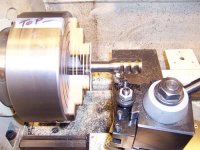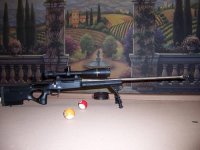You are using an out of date browser. It may not display this or other websites correctly.
You should upgrade or use an alternative browser.
You should upgrade or use an alternative browser.
there's GOT to be a better way....
- Thread starter alinwa
- Start date
M
mike in co
Guest
i'm glad you said that..
if you look close at my rifle pics( 1000yd budget)..i did not do it..it is very close to a match..not perfect...but i doubt the exterior mismatch will not affect the accuracy...
and i am the customer.....
mike in co
if you look close at my rifle pics( 1000yd budget)..i did not do it..it is very close to a match..not perfect...but i doubt the exterior mismatch will not affect the accuracy...
and i am the customer.....
mike in co
Wayne Shaw
Active member
The tapering aint so bad, but when the barrel OD isn't the same as the brake OD, and you want to make a decent looking job of it.
C
Cheechako
Guest
I would turn my brakes to within a couple of thou over the barrel diameter and then finish it off with a file. No one could tell the difference.
Since barrels seldom last more than one season I would also leave them oversize and they could be used over and over again. I don't want rifles what look good - I want rifles what shoot good.
Ray
Since barrels seldom last more than one season I would also leave them oversize and they could be used over and over again. I don't want rifles what look good - I want rifles what shoot good.
Ray
Last edited by a moderator:
ultramagmed
JKM
I usually turn my compound to where I think it is close to the angle I need for the taper. I then mount an indicator on a mighty mag to the tool post, then run it in with the cross slide and zero it at the edge of the o.d barrel just before the tenon for the brake after cutting the tenon and threading are complete. I then draw the compound out toward the end of the brake (you'll have to pull the stylus out to clear the edge of the brake). Then where ever you hit zero on the indicator on the o.d. of the brake, that is where your taper will stop. Then simply adjust the compound accordingly and re-zero on the barrel and repeat until you get the indicator to zero on the o.d. of the brake where you want the taper to stop, then cut away. If you want the brake concentric with the o.d. of the barrel you can adjust your chuck at this time also. Easier done than said.
Hope this helps,
Med.
Hope this helps,
Med.
Last edited:
LOL
My problem is a sore thumb and having to ENDLESSLY crank that hannle.
This is a large brake, lots of back and forth on the compound
I guess I'd need a lathe with a powered compound to be happy my liddle $2700.00 wonder don't cut it for speed......
my liddle $2700.00 wonder don't cut it for speed......
Ohh well, she's ready for paint
al
My problem is a sore thumb and having to ENDLESSLY crank that hannle.
This is a large brake, lots of back and forth on the compound
I guess I'd need a lathe with a powered compound to be happy
Ohh well, she's ready for paint
al
Attachments
4
4Mesh
Guest
What am I missing? That doesn't look like a big job. And, where is the taper? You mean that at the rear where it mates to the barrel?
Ray has the right idea, get the thing close and file it. Then sand. It'll look wonderful. 5 min, max.
Ray has the right idea, get the thing close and file it. Then sand. It'll look wonderful. 5 min, max.
4
4Mesh
Guest
Well then Al, I'll just say this. I've seen mor'n a few folks run a lathe, many of whom tend to be what I'd call over cautious. Most of them usually didn't spend time with anyone who ever showed them that there's a time for roughing, and a time for finishing. Anyhow, I'd guess that you're going unusually slow on the roughing phase.
If that's the case, remember there's a couple bad things about that. One, it takes a long time to get stuff done. But second, it's actually harder on the tools. 99% of tools out there (inserts/cutters/etc) are all intended for production work. So, the proper feed and speed is usually about 10x what we do in an engine lathe. I think I'm the only person I ever knew who ran a tool in an engine lathe at a faster removal rate than what was on the label! My thoughts are, 'get that material out o there!
Inserts are intended to live for a certain number of cuts. They can be light cuts, they can be heavy cuts. The insert doesn't much care, as long as it's inside it's design spec as to how much you cut. BUT! IF you make many many many little bitty cuts, they wear the cutting edge just as much (and in some cases more) than a deeper cut.
Same applies in the kitchen with cutting veggies. More cuts dulls the knife more. Matters not how thick the onion slices are... Cutting wood and splitting it up? Cut the tree into 4" sections or cut it in to 20" sections, there's just more cuts at 4". The saw gets dull faster.
I'm gonna say that brake would have been 2 passes for me. One right to left roughing in one pass, probably all but the last .020 or so. The second I'd have rotated the tool a little more point on for a left to right pass, and back cut it for the finish. Done. Sand and forget it. Maybe a half round file at the root if I wasn't really close on picking up the brake as I came off the barrel. I wouldn't want to touch off too much or I'd have another ding to fix. So, I'd have to move the carriage right till the insert was at full cut, then move on the 15deg with the compound.
Remember, it's only the last cut that matters.
If that's the case, remember there's a couple bad things about that. One, it takes a long time to get stuff done. But second, it's actually harder on the tools. 99% of tools out there (inserts/cutters/etc) are all intended for production work. So, the proper feed and speed is usually about 10x what we do in an engine lathe. I think I'm the only person I ever knew who ran a tool in an engine lathe at a faster removal rate than what was on the label! My thoughts are, 'get that material out o there!
Inserts are intended to live for a certain number of cuts. They can be light cuts, they can be heavy cuts. The insert doesn't much care, as long as it's inside it's design spec as to how much you cut. BUT! IF you make many many many little bitty cuts, they wear the cutting edge just as much (and in some cases more) than a deeper cut.
Same applies in the kitchen with cutting veggies. More cuts dulls the knife more. Matters not how thick the onion slices are... Cutting wood and splitting it up? Cut the tree into 4" sections or cut it in to 20" sections, there's just more cuts at 4". The saw gets dull faster.
I'm gonna say that brake would have been 2 passes for me. One right to left roughing in one pass, probably all but the last .020 or so. The second I'd have rotated the tool a little more point on for a left to right pass, and back cut it for the finish. Done. Sand and forget it. Maybe a half round file at the root if I wasn't really close on picking up the brake as I came off the barrel. I wouldn't want to touch off too much or I'd have another ding to fix. So, I'd have to move the carriage right till the insert was at full cut, then move on the 15deg with the compound.
Remember, it's only the last cut that matters.
C
Cheechako
Guest
Al
There's no reason the rough cut has to be done with the brake attached. Chuck it up, set the compound to whatever looks good and go at it. Then screw it on the barrel and finish it like 4Mesh said. The barrel will be worn out long before you're done admiring your work.
Ray
There's no reason the rough cut has to be done with the brake attached. Chuck it up, set the compound to whatever looks good and go at it. Then screw it on the barrel and finish it like 4Mesh said. The barrel will be worn out long before you're done admiring your work.
Ray
C
Cheechako
Guest
Al
Another hint - make yourself a BIG crank for the compound. Easier on the thumb and fingers.
Ray
Another hint - make yourself a BIG crank for the compound. Easier on the thumb and fingers.
Ray



